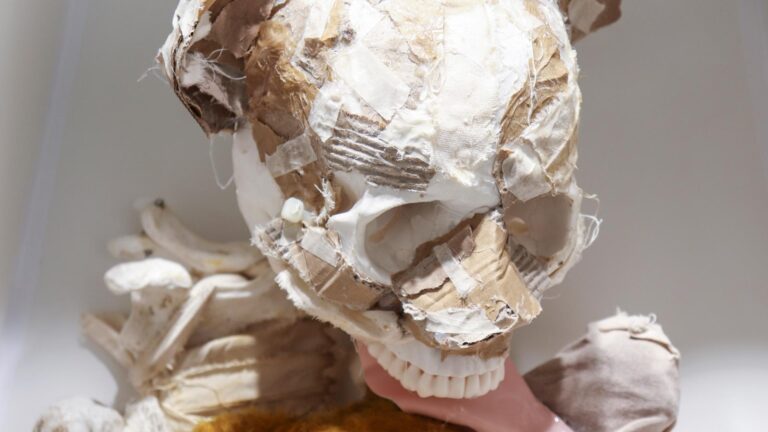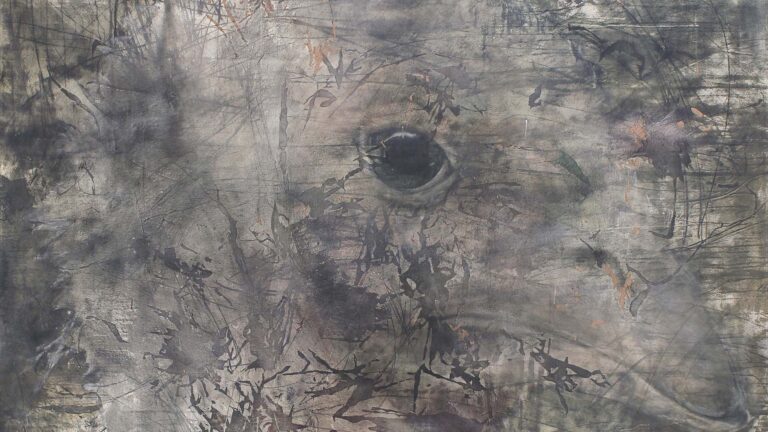Artists: Roger Bernat, Agim Çavdarbasha, Collective Exhibition for a Single Body, Thomas Dick, John Heath, Prinz Gholam, Sanja Iveković, Terre Thaemlitz, Yannis Tsarouchis, Nevin Aladağ, Nairy Baghramian, Gauri Gill, Gauri Gill and Rajesh Vangad, Ganesh Haloi, Mata Aho Collective, Naeem Mohaiemen, Rainer Oldendorf, Oskar Hansen, Edi Hila, Ibrahim Mahama, Annie Vigier & Franck Apertet (les gens d’Uterpan), Lois Weinberger
Exhibition title: documenta 14: Learning from Athens
Artistic Director: Adam Szymczyk
Curated by: Adam Szymczyk, Bonaventure Soh Bejeng Ndikung, Pierre Bal-Blanc, Hendrik Folkerts, Candice Hopkins, Hila Peleg, Dieter Roelstraete, Monika Szewczyk
Venue: documenta 14, Museum für Sepulkralkultur, Hessisches Landesmuseum, Torwache, Kassel, Germany
Date: June 10 – September 17, 2017
Photography: all images copyright and courtesy of the artists and documenta 14, all photos by Art Viewer
documenta 14: Museum für Sepulkralkultur
Opened in 1992, a few quiet footsteps from Grimmwelt Kassel, the Museum für Sepulkralkultur is entirely dedicated to the culture of death, from burial customs and memorial symbols to more everyday experiences of mortality. Throughout the museum and loosely integrated with the collection, the documenta 14 exhibition presents an ensemble of artworks and archival documents that stages the body as both an instrument and an index, as a cause or an effect, as a way to invoke history or set it in motion, as a means of oppression or a sign of the oppressed.
Prinz Gholam, various drawings, 2015-2016, Graphite on paper
Prinz Gholam, various drawings, 2015-2016, Graphite on paper
Prinz Gholam, various drawings, 2015-2016, Graphite on paper
Agim Çavdarbasha, Women of Lybeniq, 1996, Wood, Dimensions variable
Agim Çavdarbasha, Women of Lybeniq, 1996, Wood, Dimensions variable
Yannis Tsarouchis, various works, various media and materials
Yannis Tsarouchis, various works, various media and materials
Yannis Tsarouchis, various works, various media and materials
Yannis Tsarouchis, various works, various media and materials
Yannis Tsarouchis, various works, various media and materials
Yannis Tsarouchis, various works, various media and materials
Yannis Tsarouchis, various works, various media and materials
Yannis Tsarouchis, various works, various media and materials
Agim Çavdarbasha, Women of Prishtina, 1997, Wood and chain, Dimensions variable
documenta 14: Hessisches Landesmuseum
The Hessisches Landesmuseum, designed by the German historicist architect Theodor Fischer, was inaugurated in 1913; as such, it was among the last major historical museums opened before the onset of World War I and the subsequent dissolution of the German empire. Having escaped much of the bombing that reduced the vast majority of Kassel to rubble during World War II, the Landesmuseum famously housed Kassel’s celebrated collection of Flemish and Dutch Old Master paintings in the postwar era, most notably in a groundbreaking arrangement—with paintings without their historical frames—authored by documenta founder Arnold Bode in the mid-1950s. After extensive rebuilding and renovations, a revamped Landesmuseum reopened in November 2016, its commitment to the hazy question of regional identity largely intact. The austere architecture of the Antikensaal and gaudy heraldry of the Wappensaal have inspired a configuration of works by documenta 14 artists, unified in part, in their commitment to color and form, abstraction and representation, all of which go against easy identification.
Nairy Baghramian, The Iron Table (Homage to Jane Bowles), 2002, Painted wood, painted metal, sand, rope, wire, aluminum pole, and two spotlights
Nairy Baghramian, The Iron Table (Homage to Jane Bowles), 2002, Painted wood, painted metal, sand, rope, wire, aluminum pole, and two spotlights
Nairy Baghramian, The Iron Table (Homage to Jane Bowles), 2002, Painted wood, painted metal, sand, rope, wire, aluminum pole, and two spotlights
Nairy Baghramian, The Iron Table (Homage to Jane Bowles), 2002, Painted wood, painted metal, sand, rope, wire, aluminum pole, and two spotlights
Ganesh Haloi, Untitled, 2009-2015, Gouache on paper
Ganesh Haloi, Untitled, 2009-2015, Gouache on paper
Ganesh Haloi, Untitled, 2009-2015, Gouache on paper
Ganesh Haloi, Untitled, 2009-2015, Gouache on paper
Ganesh Haloi, Untitled, 2009-2015, Gouache on paper
Mata Aho Collective, Kiko Moana, 2017, Polyethene tarpaulin and cotton thread
Rainer Oldendorf, marco14, 2017, Digital video, color, sound, duration variable
Nevin Aladağ, Jali, 2017, Glazed ceramics
Nevin Aladağ, Jali, 2017, Glazed ceramics
Nevin Aladağ, Jali, 2017, Glazed ceramics
Nevin Aladağ, Jali, 2017, Glazed ceramics
Naeem Mohaiemen, Two meetings and a funeral, 2017, three-channel digital video installation, color, sound, 85min.
Naeem Mohaiemen, Two meetings and a funeral, 2017, three-channel digital video installation, color, sound, 85min.
documenta 14: Torwache
Today’s Torwache is the remnant of a palatial building plan cut short by the Napoleonic wars and invasions of the early nineteenth century. Designed by local architect Heinrich Christoph Jussow, best remembered for his work on the Schloss Wilhelmshöhe and its surrounding Bergpark, the two structures that together form the Torwache were conceived as a framing device connecting the Bergpark’s royal residence and strolling grounds with Kassel’s medieval city center. It crowns the grand vista afforded by Wilhelmshöher Allee—a view popular with the cream of Nazi Germany’s military crop, who dreamt up grand designs for the so-called Gauhauptstadt Kassel.
The Monument to the Victims of Fascism in Auschwitz-Birkenau by Oskar Hansen and paintings by Edi Hila inside the Torwache reflect upon the ideological knot of urban planning and the politics of axial organization. The exterior of the building is enveloped in an installation by Ibrahim Mahama, whose stitched jute sack collage recounts multiple histories of global trade, individual narrations of possession and dispossession, scars of a larger narrative of migration, as well as technologies of masking and camouflage.
Ibrahim Maham, Check Point Sekondi Loco. 1901–2030. 2016–2017, 2016–2017, Charcoal sacks, scrap metal, tarpaulins, metal tags, and leather from Henschel train interior
Edi Hila, Boulevard 1–6, 2015, Oil on canvas
Edi Hila, Boulevard 1–6, 2015, Oil on canvas
Edi Hila, Boulevard 1–6, 2015, Oil on canvas
Edi Hila, Boulevard 1–6, 2015, Oil on canvas
Edi Hila, Boulevard 1–6, 2015, Oil on canvas
Oskar Hansen, Design for the Monument to the Victims of Fascism in Auschwitz-Birkenau, 1957, With Zofia Hansen, Jerzy Jarnuszkiewicz, Edmund Kupiecki, Julian Pałka, and Lechosław Rosiński , Architectural model and drawings, photographs, and prints on cardboard and plywood
Oskar Hansen, Design for the Monument to the Victims of Fascism in Auschwitz-Birkenau, 1957, With Zofia Hansen, Jerzy Jarnuszkiewicz, Edmund Kupiecki, Julian Pałka, and Lechosław Rosiński , Architectural model and drawings, photographs, and prints on cardboard and plywood
Oskar Hansen, Design for the Monument to the Victims of Fascism in Auschwitz-Birkenau, 1957, With Zofia Hansen, Jerzy Jarnuszkiewicz, Edmund Kupiecki, Julian Pałka, and Lechosław Rosiński , Architectural model and drawings, photographs, and prints on cardboard and plywood
Oskar Hansen, Design for the Monument to the Victims of Fascism in Auschwitz-Birkenau, 1957, With Zofia Hansen, Jerzy Jarnuszkiewicz, Edmund Kupiecki, Julian Pałka, and Lechosław Rosiński , Architectural model and drawings, photographs, and prints on cardboard and plywood
Oskar Hansen, Design for the Monument to the Victims of Fascism in Auschwitz-Birkenau, 1957, With Zofia Hansen, Jerzy Jarnuszkiewicz, Edmund Kupiecki, Julian Pałka, and Lechosław Rosiński , Architectural model and drawings, photographs, and prints on cardboard and plywood
Oskar Hansen, Design for the Monument to the Victims of Fascism in Auschwitz-Birkenau, 1957, With Zofia Hansen, Jerzy Jarnuszkiewicz, Edmund Kupiecki, Julian Pałka, and Lechosław Rosiński , Architectural model and drawings, photographs, and prints on cardboard and plywood

















































